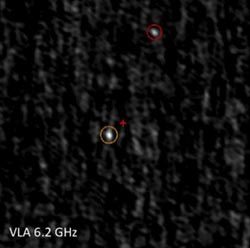MSU-led research finds another black hole in a star cluster

This an image of globular cluster M62 captured by a radio telescope. The star-like object within the orange circle is believed to be a black hole discovered by a team of researchers led by an MSU astronomer. Photo courtesy of the National Radio Astronomy Observatory.<br>
Researchers are now thinking it was the former, as evidence of yet another black hole has been found in a globular cluster by an MSU-led team of researchers.
As published in the recent issue of Astrophysical Journal, a new black hole candidate has been found in a globular cluster known as M62.
“This implies that the discovery of the other black hole, in the globular cluster called M22, was not just a fluke,” said Laura Chomiuk, team member and MSU assistant professor of physics and astronomy. “Black holes really may be common in globular clusters.”
Black holes are stars that have died, collapsed into themselves and now have such a strong gravitational field that not even light can escape from them.
The globular cluster M62 is located in the constellation Ophiuchus, about 22,000 light years from Earth.
Until recently, astronomers had assumed that the black holes did not occur in globular clusters, which are some of the oldest and densest collections of stars in the universe. Stars are packed together a million times more closely than in the neighborhood of our sun.
There are so many stars in such a condensed area that they often interact with one another. Massive black holes would have the most violent encounters, “sling-shotting” each other out of the cluster.
Last year’s discovery of a pair of black holes in a cluster was especially surprising, Chomiuk said. It had been thought that if two black holes dwelled at the center, they would regularly encounter one another until one shoved the other out.
“I think it’s safe to say that we have discovered a whole new hunting ground for black holes,” said Chomiuk.
This latest discovery was made by using the National Science Foundation’s Karl G. Jansky Very Large Array telescope in New Mexico.
To view the paper, visit http://iopscience.iop.org/0004-637X/777/1/69/article.
Media Contact
More Information:
http://www.msu.eduAll latest news from the category: Physics and Astronomy
This area deals with the fundamental laws and building blocks of nature and how they interact, the properties and the behavior of matter, and research into space and time and their structures.
innovations-report provides in-depth reports and articles on subjects such as astrophysics, laser technologies, nuclear, quantum, particle and solid-state physics, nanotechnologies, planetary research and findings (Mars, Venus) and developments related to the Hubble Telescope.
Newest articles

Security vulnerability in browser interface
… allows computer access via graphics card. Researchers at Graz University of Technology were successful with three different side-channel attacks on graphics cards via the WebGPU browser interface. The attacks…

A closer look at mechanochemistry
Ferdi Schüth and his team at the Max Planck Institut für Kohlenforschung in Mülheim/Germany have been studying the phenomena of mechanochemistry for several years. But what actually happens at the…

Severe Vulnerabilities Discovered in Software to Protect Internet Routing
A research team from the National Research Center for Applied Cybersecurity ATHENE led by Prof. Dr. Haya Schulmann has uncovered 18 vulnerabilities in crucial software components of Resource Public Key…





















